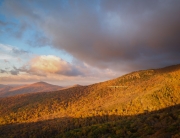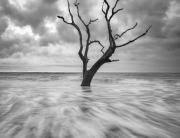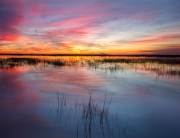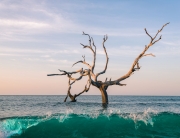
I’ve been really interested in Long Exposure Seascapes for a long time. There is something dreamy and soothing about the misty foamy water and the streaking clouds. Because you can’t see this with the naked eye and rely on the gathering of light into the camera sensor, to me, these type of images become even more artistic. I’m not saying that other photographic techniques are not art, but maybe these long exposures require more vision and creativity.
Above is a recent long exposure seascape that I capture on the rocky coast of Newport, Rhode Island. A light snowfall the day and night before helped to create some incredible visual interest in the rocky foreground and the clearing heavy cloud suggested a great sunrise. I got there early and setup right on the edge of the water. As close as I could get without getting wet. 🙂
Capturing Long Exposure Seascapes
Creating long exposures is fairly easy. All you need to do is make sure that the shutter speed is long enough to show movement in your scene. That being said how much movement and how long to leave the shutter open becomes the important questions. For a seascape like the one above, how much the sea is foamy and specifically how much white water is present is important. Most of the time a minute or longer will give you pleasing results for the water. The sky is much trickier. One needs to watch the cloud movement and anticipate how far clouds will move during one, two, four minutes etc. In this case the clouds were moving pretty rapidly and I knew that anything over 2 minutes would work.
Details of this shot
Specifically all of this worked out to an ISO of 100, and Aperture of f/13 and a 4 minute exposure using a 2 stop hard edge ND Grad, and a 10 stop ND filter. My 10 stop (Lee Big Stopper) is actually more closer to 11 stops. So I have to factor that into my calculations while I’m out shooting. Another thing that becomes important is the changing light. In this situation with clearing clouds at sunrise I had to factor in about a 2/3 stop less due to the increasing light. The good thing about long exposures in the cold like this is that you can put your gloves on and hang out watching the sunrise. The bad thing is watching the tide coming in and wondering if you will have to grab your tripod away from an unruly wave thereby messing up your 4 minute exposure.
Remember to compose carefully and set your focus point before putting on an ND filter. Then switch it to manual focus and remember to close the viewfinder. Light leaks are a real problem with long exposures and leaving the viewfinder open will ruin your final image.
After capturing your image, processing long exposures is a lot of fun. Removing the color cast and then deciding how you want to work an image is part of the adventure. Determining to convert an image to black and white is a tricky decision and the only reason I decided to do that here was because of the interesting tones in the rocks, snow, ice and water and the limited color in the sky. I used Lightroom, Photoshop and Nik Color and Silver Efex to end up with this result. I used Nik Color Efex initially to remove the color cast, and then converted it to black and white using the incredible Silver Efex.
Cheers for now!





























